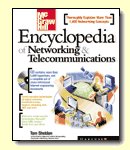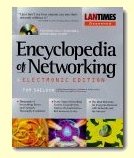|
Site home page
(news and notices)
Get alerts when Linktionary
is updated
Book updates and addendums

Get info about the Encyclopedia of Networking
and Telecommunicatons, 3rd edition (2001)

Download the electronic version of the Encyclopedia
of Networking, 2nd edition (1996). It's free!
Contribute to this site
Electronic licensing info
|
|
Concentrator Devices
Related Entries Web Links New/Updated Information
Note: Many topics at this site are reduced versions of the text in "The Encyclopedia of Networking and Telecommunications." Search results will not be as extensive as a search of the book's CD-ROM.
A concentrator is a device that provides a central connection point for the connection of terminal, computer, or communication devices. It can be a central point where cables converge. Technically, a concentrator merges a certain number of incoming lines with a number of outgoing lines, or provides a central communication link for a number of devices. Several types of concentrators are listed here:
- Concentrators
In the mainframe environment, a concentrator can merge the lines from a number of terminals and provides a link to another concentrator in a hierarchical arrangement, or links directly to the front-end processor of a host computer. Data from the low-speed terminal lines is transferred over a high-speed line using a multiplexing method or a contention method. In the multiplexing method, a terminal gets a fixed time slot in the multiplexed stream. In the contention method, each low-speed line gets full access to the high-speed line for a brief period. See "Mainframe" for more information.
- Front-end processors
A front-end processor is similar to the concentrator just described in function, but it is usually a dedicated computer in its own right that performs concentration functions at higher speeds and supports more attached devices. See "Mainframe" for more information.
- LAN concentrators
In the LAN (local area network) environment, concentrators have grown from simple wire management facilities to hub devices that provide "collapsed backbone," bridging, and routing functions. A collapsed backbone is equivalent to shrinking a bus cable system like Thinwire coaxial Ethernet down to the size of a small box. A separate wire of inexpensive twisted-pair wire then runs to each workstation. See "Network Connection Technologies." "Switch Fabrics and Bus Design," and "Ethernet."
- Port-sharing and selector units
Port-sharing units provide a way for multiple terminals at a remote site to share a modem connection to a computer or host system. The device fits in between the terminals and the modem.
- Multiplexers
The original design of a multiplexer was based on a need to reduce the cost of data transmissions for terminal devices that needed to communicate with a host device over a telecommunication link. A multiplexer is a device that merges the data from multiple terminals into one line and then ships the merged data over the link, where it is demultiplexed at the other end. Multiplexing cost-justifies the leasing of a high-speed digital line such as T1. See "Multiplexing and Multiplexers" for more details.
Copyright (c) 2001 Tom Sheldon and Big Sur Multimedia.
All rights reserved under Pan American and International copyright conventions.

|

